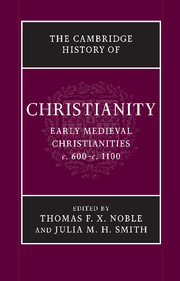Book contents
- Frontmatter
- Introduction: Christendom, c. 600
- Part I Foundations: Peoples, Places, and Traditions
- Part II Christianity in Confrontation
- Part III Christianity in the Social and Political Order
- Part IV Christianity as Lived Experience
- 18 Birth and death
- 19 Remedies for sins
- 20 Sickness and healing
- 21 Gender and the body
- 22 Sacrifice, gifts, and prayers in Latin Christianity
- 23 Performing the liturgy
- Part V Christianity: Books and Ideas
- Conclusion: Christendom, c. 1100
- Bibliographies
- Index
- References
23 - Performing the liturgy
from Part IV - Christianity as Lived Experience
Published online by Cambridge University Press: 28 March 2010
- Frontmatter
- Introduction: Christendom, c. 600
- Part I Foundations: Peoples, Places, and Traditions
- Part II Christianity in Confrontation
- Part III Christianity in the Social and Political Order
- Part IV Christianity as Lived Experience
- 18 Birth and death
- 19 Remedies for sins
- 20 Sickness and healing
- 21 Gender and the body
- 22 Sacrifice, gifts, and prayers in Latin Christianity
- 23 Performing the liturgy
- Part V Christianity: Books and Ideas
- Conclusion: Christendom, c. 1100
- Bibliographies
- Index
- References
Summary
In effecting, at the very highest level of existence, the connection and constant transactions between man and God, between the tangible universe and eternity, the liturgy illustrated this propensity [for sensory participation] in an exemplary way. Spectacular, even in its smallest aspects, it signified the truths of the faith by means of a complex play on the senses of hearing (through music, chants, reading), sight (through the grandeur of the edifices; by the actors, their dress, their gestures, their dance and by the setting) and even touch: the sacred wall was touched; the foot, the reliquary, the episcopal ring kissed; the fragrance of incense and of candlewax inhaled.
Without doubt, the liturgy – the ritual of the Christian church in antiquity and in the Middle Ages – is one of the fields of medieval studies to benefit most in recent years from new developments in both research methods and the sorts of questions raised. Long considered the preserve of clerical researchers (especially in France) where complementary theological and textual approaches held sway, the study of the liturgy has in recent years enjoyed a resurgence in the field of medieval studies. Responding to the various historiographical traditions of each country, this phenomenon was to a large extent made possible by the influence of historical anthropology. The study of rites and, more generally speaking, of ritual phenomena is central to this approach. Applied to the study of medieval civilization, historical anthropology has made the pivotal role played by the liturgy in medieval society more and more apparent.
- Type
- Chapter
- Information
- The Cambridge History of Christianity , pp. 472 - 488Publisher: Cambridge University PressPrint publication year: 2008
References
- 3
- Cited by

